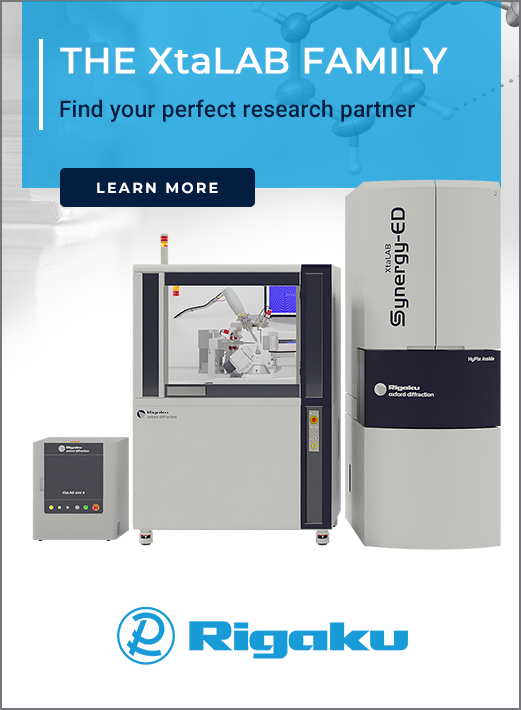


Application note
Optimization of protein crystals obtained with the FUSION screen
![thumbnail [thumbnail]](https://www.iucr.org/__data/assets/image/0009/154692/thumbnail.jpg)
FUSION formulation
The most efficient components of the three MORPHEUS crystallization screens have been combined into a single 96-condition screen called FUSION. FUSION integrates 17 previous MORPHEUS mixes of additives ("LiNaK", "alkalis", "polyamines", etc.) and two new mixes ("cryopolyols" and "NDSBs"). Mixes of additives were paired to form 96 unique combinations (see some examples in Table 1). FUSION also integrates the four mixes of precipitants and three buffer systems of the original MORPHEUS screen. All components were systematically sampled to formulate an incomplete factorial. The efficiency of FUSION was demonstrated by producing useful crystallization hits with test samples in multiple FUSION conditions (Fig. 1).
For more details about the FUSION screen, please refer to the original publication: Gorrec & Bellini (2022).
Table 1. Examples of crystallization conditions in the FUSION screen. The eight conditions listed are the ones that produced the crystallization hits shown in Fig. 1. In FUSION, there are 81 conditions prepared with two mixes of additives each, such as C6, D6, D8, F11, G5 and G8 shown here. The 15 other FUSION conditions are prepared with only one mix of additives (e.g. H11 and H12), whose concentration is doubled compared with when they are paired with another one. For example, the concentration of the mix “polyamines” is 10 mM in F11 whereas it is 20 mM in H11.
| Well | Mix of precipitants | Buffer system | Mix of additives (set 1) | Mix of additives (set 2) |
|---|---|---|---|---|
| C6 | 12.5% w/v PEG 1000, 12.5% w/v PEG 3350, 12.5% v/v MPD | 0.1 M bicine/Trizma base pH 8.5 | 30 mM of each LiNaK | 20 mM of each monosaccharide 1 |
| D6 | 10% w/v PEG 20 000, 20% v/v PEG MME 500 | 0.1 M bicine/Trizma base pH 8.5 | 30 mM of each LiNaK | 20 mM of each monosaccharide 2 |
| D8 | 10% w/v PEG 4000, 20% v/v glycerol | 0.1 M bicine/Trizma base pH 8.5 | 1 mM of each alkali | 20 mM of each monosaccharide 2 |
| F11 | 10% w/v PEG 4000, 20% v/v glycerol | 0.1 M MOPS/HEPES-Na pH 7.5 | 10 mM of each polyamine | 0.5% w/v of each cryopolyol |
| G5 | 10% w/v PEG 8000, 20% v/v ethylene glycol | 0.1 M bicine/Trizma base pH 8.5 | 20 mM of each amino acid | 0.3% w/v of each NDSB |
| G8 | 10% w/v PEG 20 000, 20% v/v PEG MME 500 | 0.1 M MES/imidazole pH 6.5 | 1 mM of each alkali | 0.3% w/v of each NDSB |
| H11 | 10% w/v PEG 20 000, 20% v/v PEG MME 500 | 0.1 M MES/imidazole pH 6.5 | 20 mM of each polyamine | None |
| H12 | 10% w/v PEG 8000, 20% v/v ethylene glycol | 0.1 M MES/imidazole pH 6.5 | 0.4% w/v of each anaesthetic alkaloid | None |
![[Fig1]](https://www.iucr.org/__data/assets/image/0010/154693/Fig1.jpg)
Optimizing the concentration of the main components
Despite the success of FUSION with test samples, where many diffraction quality crystals could be obtained without further optimization (Fig. 1), in most cases it will be required to optimize crystal growth by setting up modified experiments based on the initial FUSION hits. For this, it is normally required to investigate the impact of varying the concentrations of the main components of the condition that produced that hit, and to observe effects on crystal nucleation and growth.
As with the original MORPHEUS formulation, the simplest way to approach optimization with FUSION is to consider each mix of reagents as a single component. When there are two mixes of additives in a condition, the corresponding stock solutions can also be combined to reduce the number of components and parameters to test and investigate. Because of the systematic nature of the FUSION formulation, the starting ratios between components is always 0.5 mix of precipitants + 0.2 mix of additives from set 1 and/or 2 + 0.1 buffer system + 0.2 water.
At the Laboratory of Molecular Biology, we recommend using the "4-corner solutions" method to produce 2D concentration gradient screens (Fig. 2). The initial step is to prepare 4-corner premixes "A, B, C and D” manually. This is to handle difficult solutions with a relatively large volume range and bypass the liquid-classes programming with automated liquid handling technology. Based on the fixed ratios of stock solutions in FUSION, the formulation of the required 4-corner premixes "A, B, C and D" to vary the concentration of precipitants and additives will typically be as follows:
- Solution A: 0.35 mix of precipitants + 0.05 mix of additives from set 1 and 2 + 0.1 buffer system + 0.5 water
- Solution B: 0.55 mix of precipitants + 0.05 mix of additives from set 1 and 2 + 0.1 buffer system + 0.3 water
- Solution C: 0.35 mix of precipitants + 0.25 mix of additives from set 1 and 2 + 0.1 buffer system + 0.3 water
- Solution D: 0.55 mix of precipitants + 0.25 mix of additives from set 1 and 2 + 0.1 buffer system + 0.1 water.
![[Fig2]](https://www.iucr.org/__data/assets/image/0011/154694/Fig2.jpg)
Optimizing the pH
Apart from varying the concentration screen components, the pH is often an important variable that is typically investigated in parallel with the concentrations of precipitants and additives. This can be done by preparing separate 2D concentration gradient screens (Fig. 2), each containing a buffer adjusted to different pH values. Conveniently, the preparation of buffers adjusted to different pH values is made straightforward with the MORPHEUS buffer systems (Table 2).
For more details about the MORPHEUS buffer systems, please refer to the original publication: Gorrec (2009).
Table 2. Recipes for preparing the three MORPHEUS buffer systems as used in the FUSION screen. Buffers are pH-adjusted by mixing 1 M stock solutions of acidic and basic buffer molecules. The table lists volumes of the stock solutions needed to yield 50 ml of buffer mix. The buffer mix preparations should be checked with a pH meter. Please note that a pH meter equipped with a solid-state probe will avoid inaccuracies with Tris-containing buffers, unless explicit corrections are applied when using other probes.
| pH | 1 M MES (ml) | 1 M imidazole (ml) |
|---|---|---|
| 6.1 | 36.0 | 14.0 |
| 6.3 | 33.5 | 16.5 |
| 6.5 | 30.6 | 19.4 |
| 6.7 | 27.5 | 22.5 |
| 6.9 | 25 | 25 |
| pH | 1 M MOPS (ml) | 1 M HEPES-Na (ml) |
| 7.1 | 34.5 | 15.5 |
| 7.3 | 30 | 20 |
| 7.5 | 25.9 | 24.1 |
| 7.7 | 22.1 | 37.9 |
| 7.9 | 17.7 | 32.3 |
| pH | 1 M bicine (ml) | 1 M TRIS-base (ml) |
| 8.1 | 35.6 | 14.4 |
| 8.3 | 31.7 | 18.3 |
| 8.5 | 26.7 | 23.3 |
| 8.7 | 21.2 | 28.8 |
| 8.9 | 15 | 35 |
"Biasing experiments" to increase chances during optimization
When an additive mix is revealed as being essential during the optimization of an initial hit condition, we recommend adding the additive mix to the sample and then to screen against other crystallization screens. This "biasing" of the sample often increases the yield of useful crystals and can be particularly helpful when a better crystal form is needed through re-screening [Fig. 3(a)]. Conversely, when a precipitant mix is revealed as essential in the initial screen or optimization, a custom-made FUSION screen formulated with a single precipitant mix (instead of the normally used four different ones) can be an efficient approach to additive screening as FUSION combines so many different additives [Fig. 3(b)]. All mixes needed to proceed with optimization work are available commercially as ready-made stock solutions, making this task even more straightforward.
![[Fig3]](https://www.iucr.org/__data/assets/image/0003/154695/Fig3.jpg)
This work was supported by the Medical Research Council (MRC), as part of United Kingdom Research and Innovation. FUSION is sold by Molecular Dimensions Ltd as "MORPHEUS® FUSION" under an exclusive licence from the MRC and the medical research charity LifeArc.
References
Gorrec, F. (2009). The MORPHEUS protein crystallization screen. J. Appl. Cryst. 42, 1035–1042.
Fabrice Gorrec is located at the MRC Laboratory of Molecular Biology (Cambridge, UK). François-Xavier Robert is located at LifeArc (London, UK). Claire Seddon and Simon Tanley are located at Molecular Dimensions (Sheffield, UK).
Correspondence: [email protected]
Copyright © - All Rights Reserved - International Union of Crystallography








